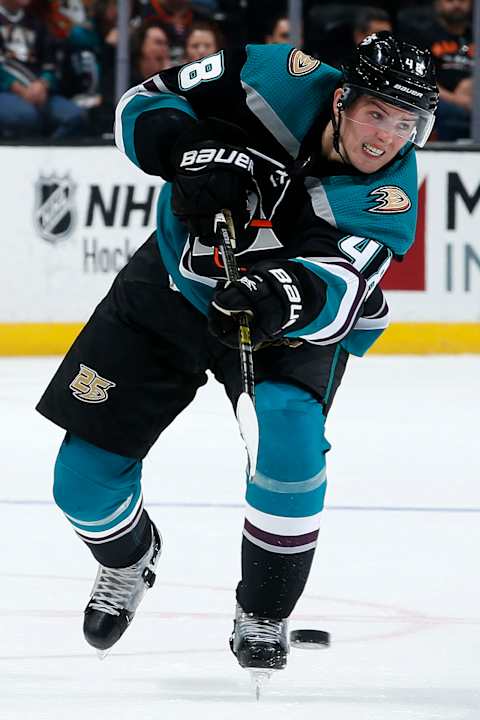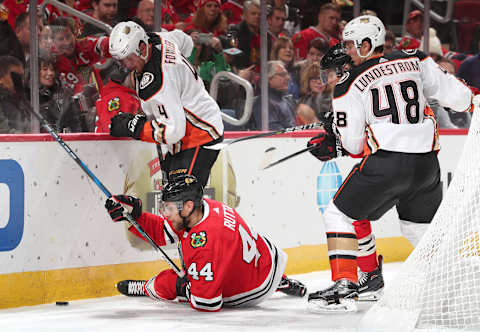Anaheim Ducks: What it Means to Burn an ELC Year for Max Comtois


For rookies in the NHL, there are several big milestones, first game, first goal, first assist etc. But for the management of those rookie’s teams, there are two milestones that are even more important than any other. The 10 games played mark, and the 42 games played mark.
The reasoning for this is slightly complicated but it’s important. When players are drafted in the NHL, the team who drafts them owns their rights, meaning no other NHL team can sign them. The length of time that a team owns a players rights is determined by where the player played prior to being drafted, it’s an odd system but it goes as follows.
If a player played college hockey in the US, (Troy Terry, Jimmy Vesey, Justin Schultz) the team who drafts them will retain their rights until 30 days after they leave college. If they do not sign with the team who drafts them, they become an unrestricted free agent, free to sign wherever they choose.
If a player played in Europe prior to being drafted, the team who drafts them will retain their rights for 4 years before they are a free agent.
And lastly, if a player played in the CHL, teams will own their rights for 2 years after they draft them before they become a UFA.

But we’re not here today to talk about the confusing system of who owns the rights to a player they drafted and for how long. We’re going to talk about what happens with players after they sign their entry-level contract. Once a player signs an entry-level contract, they become bound to the team they sign with for much longer than any of the above numbers, and it’s why the 10 games played and 42 games played milestones are so important in a rookie season.
An entry-level deal for a player drafted in the NHL is for 3 seasons, and consists of an incredibly minuscule cap hit. Most high-end players are signed to the maximum value entry-level deal, and that comes with a price tag of under one million a season. Whether it’s Connor McDavid or John Dahlstrom their cap hit will be roughly the same.
In the NHL there’s a rule known as “sliding” your entry-level deal. This is where the first milestone comes in to play. If an 18 or 19-year-old player signs a contract and makes an NHL roster, the first nine games are for lack of a better term, playing with house money. Meaning if the team sends them back down to your junior team, or sends them back to Europe any time during games one through nine, their contract will slide a season, but the second they touch the ice for their tenth game of the season, their contract is activated and the clock starts ticking. After the contract is activated there’s no potential for a slide, and after 3 seasons from the activation season, the player will become a restricted free agent.
A restricted free agent is not technically free, they are able to sign a contract with any team in the NHL, however, they must sign an “offer sheet” as opposed to simply signing a contract. The team who owns the players right then has 7 days to decide whether they want to match the offer or let the player walk and receive compensation. The compensation ranges from nothing all the way up to four first-round draft selections. For full details on compensation check the list here.

The second milestone, the 42 games played milestone is important in regards to how long a player is considered a restricted free agent as opposed to an unrestricted free agent. Once a player plays 42 games in their rookie season, they accrue a full season played. A player becomes an unrestricted free agent after reaching the age of 27 or after playing 7 NHL seasons. After playing that 42nd game, the player will be eligible to be an unrestricted free agent one season early.
But why is this important in the case of Maxime Comtois or Isac Lundestrom? Teams have a decent amount of leverage in regards to restricted free agents. Offer sheets are rare in the NHL, and if the player is not willing to sign with the team who owns their rights, they are basically stuck in a limbo of sorts as they more times than not as they are faced with either sitting out, or taking less money than what they’d get on the open market. In having that leverage it’s a benefit to the team as they can usually save pivotal cap dollars. It’s one of a shrewd GM’s greatest tools and one that Bob Murray takes full advantage of.
When it comes to Comtois and Lundestrom the question became is it be easier to sign them in 2020 or 2021. Personally, I think the Ducks made the right choice in saying it will be easier to sign them in 2020. As it stands at this moment, the Ducks will have over 20 million dollars of cap space opening up with the massive contracts of Ryan Getzlaf and Corey Perry expiring as well as Andrew Cogliano‘s contract expiring.
No-one can say for sure what the future will hold regarding these 3 or whether they’ll even be on the team when their contract expires. But assuming the aging Getzlaf and Perry don’t find the fountain of youth, it’s safe to say they won’t be tying up 17 million in cap space between the two of them whether they’re re-signed or not. This gives the Ducks General Manager (Be it Bob Murray or someone else) quite a bit of breathing room. The Ducks currently would need to re-sign Comtois, Lundestrom, Sam Steel, Ondrej Kase, Max Jones and Josh Mahura, and assuming none of them turn into All-Star caliber players between now and then, it’s certainly possible to stretch that extra cap space.
But what about if they did decide to let the contract slide? Well, honestly I think that is where things would have gotten difficult. Yes Getzlaf, Perry and Cogliano would all still be off the books, or on less significant deals, but in addition to signing the players all listed above the year before, the Ducks will also have to find space for franchise cornerstones Hampus Lindholm, Rickard Rakell and top 4 defenseman Josh Manson to sign, and the only notable contract that will expire following the 2020 season is Ryan Kesler which does open up a good chunk of cap space at 6.8 million.

Personally, I feel it’s a smart move to put yourself in the position that you need to lock up some of the younger players earlier, it gives you a chance to find real value contracts like the one that Rickard Rakell is currently on, and Cam Fowler was on before him. Yes, it may risk rushing the player a bit, but it’s a risk that could lead to a big reward down the line.
More from Pucks of a Feather
- Who could the Anaheim Ducks consider presenting offer sheets to?
- Is Pierre-Luc Dubois on the cards for the rebuilding Anaheim Ducks?
- Making the case for the Anaheim Ducks to trade with the Edmonton Oilers
- Anaheim Ducks might benefit tremendously by trading John Gibson
- How close are the Anaheim Ducks to becoming contenders again?
By forcing themselves to lock up all of their current young pieces in one off-season, it does also, in my opinion, help by giving you a concrete outline of what your franchise looks like, and what you have to spend going into a season where 3 huge names are looking for new deals, which gives the General Manager a chance to devote more attention to signing those 3, by having one or two less name to lock up.
Will this move work out long term? It’s difficult to say, but when you look at the Ducks track record of keeping up young players past that 9 game slide period, for the most part, it’s worked out well. Murray is notoriously conservative with his players, and if he feels that they are ready to make the jump, given how that turned out for guys like Hampus Lindholm, and Fowler, I am of the opinion that he is making the right decision.
Anaheim Ducks Fan Stories: Hockey Breeds Rebellion. dark. Next